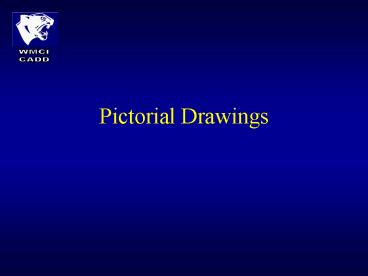Pictorial Drawings PowerPoint PPT Presentation
1 / 19
Title: Pictorial Drawings
1
Pictorial Drawings
2
Axonometric Projections
3
Step by StepIsometric Sketching
4
Isometric Projection vs. Sketch
Isometric projections are foreshortened because
the object is tipped with respect to the viewing
plane. Isometric sketches are not usually
foreshortened because they still appear
proportionate when showing the dimensions full
size along isometric axis lines. It is easier
just to sketch the full dimension.
5
Locating Features
To locate a feature such as the upper block, make
measurements from an existing corner as shown
here.
6
Inclined Surfaces in Isometric
Inclined surfaces can not be measured along
inclined lines in an isometric sketch. To locate
inclined surfaces you must make measurements
along the isometric axis lines.
7
Circles in Isometric
- Circles appear as ellispses when drawn in an
isometric sketch. - To sketch an isometric circle, locate the center
and then sketch the box that would enclose the
circular shape. Draw the ellispse tangent to the
lines of the box.
8
Arcs in Isometric Sketches
Arcs are usually sketched by locating their
centers and then boxing in the enclosing
parallelogram. Sketch the arc tangent to the
enclosing box, which is drawn along isometric
lines.
9
Hidden Lines
Hidden lines are not usually shown in isometric
sketches unless they are needed to show a feature
that would be unclear. Usually the orientation
for the isometric drawing should be chosen so
that hidden lines arent needed. Holes are
assumed to go completely through the object
unless their depth is indicated with a note or
with hidden lines.
10
Exploded Isometric Assembly
Isometric drawings are frequently used to show
how parts assemble as in this automobile power
module.
11
Oblique Pictorials
The advantage of oblique pictorials like these
over isometric pictorials is that circular shapes
parallel to the view are shown true shape, making
them easy to sketch. Oblique pictorials are not
as realistic as isometric views because the depth
can appear very distorted. Oblique views cannot
usually be generated directly from a 3D model
using CAD. It is primarily a sketching technique.
12
Unnatural Appearance ofOblique Drawing
Oblique drawings of objects having a lot of depth
can appear very unnatural due to the lack of
foreshortening.
13
Perspective Drawings
- Perspective drawings produce the view that is
most realistic. A perspective drawing shows a
view like a picture taken with a camera - There are three main types of perspective
drawings depending on how many vanishing points
are used. - These are called one-point, two-point, and
three-point perspectives.
14
One Point Perspective
Orient the object so that a principal face is
parallel to the viewing plane (or in the picture
plane.) The other principal face is perpendicular
to the viewing plane and its lines converge to a
single vanishing point.
15
Terminology
16
One-point Perspective Sketching
1.
Sketch front surface of object and locate
vanishing point.
17
Sketch receding lines
2.
Sketch receding lines from intersections and
points of tangency on front surface to vanishing
point.
18
3.
Estimate the depth of the object you will show
and block in the back surface between the
receding lines.
19
Shading Techniques

